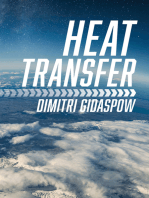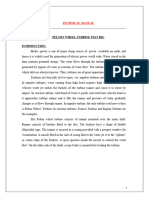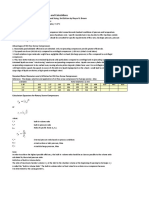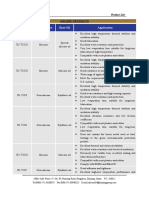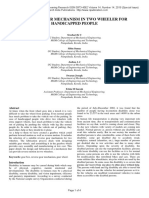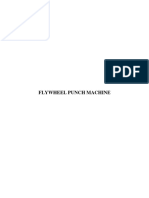Expt No: Date:: Load Test On Pelton Wheel
Expt No: Date:: Load Test On Pelton Wheel
Uploaded by
Alex ChollackalCopyright:
Available Formats
Expt No: Date:: Load Test On Pelton Wheel
Expt No: Date:: Load Test On Pelton Wheel
Uploaded by
Alex ChollackalOriginal Title
Copyright
Available Formats
Share this document
Did you find this document useful?
Is this content inappropriate?
Copyright:
Available Formats
Expt No: Date:: Load Test On Pelton Wheel
Expt No: Date:: Load Test On Pelton Wheel
Uploaded by
Alex ChollackalCopyright:
Available Formats
ST.
JOSEPH’S COLLEGE OF ENGINEERING AND TECHNOLOGY
HYDRAULICS MACHINES LABORATORY MANUAL Page 1
Expt No:
Date:
LOAD TEST ON PELTON WHEEL
AIM
To find the operating characteristic curves of Pelton Wheel at constant speed
and constant head and plot the following graphs
1. Efficiency Vs Output
2. Discharge Vs Output
3. Input Vs Output
APPARATUS
Pelton wheel fitted with loading arrangements, a pumping unit to supply water
at the required head, discharge measuring arrangements, tachometer, and gauges
PRINCIPLE
The turbine is run at constant speed and head specified by manufacturer and
efficiency of the turbine is determined by measuring the output torque of the machine
from zero to the rated maximum. The power output can be determined by measuring
the torque output of the turbine using rope brake arrangement.
Calculate the maximum value of (W-S) correspond to rated power. This can
be divided in to 6 equal parts approximately, and the machine can be loaded each time
with the corresponding load.
Maximum load calculation
Rated power in KW = 2πN(W-S)R
60 x 1000
N - Speed in rpm
W - Load on the pan in N
S - Spring balance reading in N
R - Effective Brake drum radius in Meter
PROCEDURE
1. Keep the nozzle at about 3/8th open position
2. Prime the pump if necessary
3. Keep the turbine in unloaded position. (No load on spring)
4. Close the delivery gate valve completely and start the pump
5. Open the delivery gate valve until the venturimeter pressure gauges indicate a
differential pressure of about 0.6Kg/sq.cm-this correspond to design flow rate
6. Note the turbine inlet pressure and keep at a constant head of 4.6Kg/sq.cm of water
in the pressure gauge fixed in the nozzle bend.
7. Keep the speed constant at the rated value
8. Note the venturimeter pressure gauge readings.
9. Load the turbine by adding weights to the hanger.
10. Repeat the experiment for different loads, keeping the speed constant by adjusting
the delivery gate valve.
11. Release the load simultaneously closing the delivery valve and then switch off the
Pump.
DEPARTMENT OF MECHANICAL ENGINEERING
ST.JOSEPH’S COLLEGE OF ENGINEERING AND TECHNOLOGY
HYDRAULICS MACHINES LABORATORY MANUAL Page 2
TABULATION AND OBSERVATIONS
Brake drum diameter, d1 = 0.40m
Rope diameter, r2 = 0.015m
Equivalent drum radius = r1 + r2 =
Hanger weight, T0 = 1 Kg
Spring balance error = S Kg =
Speed of the turbine = rpm
Cd = 0.98
Inlet Total Venturimeter Pressure Q* Wt. on Wt on Net Wt Turbine Input Efficiency
Sl Pressure head readings Gauge -3 hanger spring T Output KW %
10
No P H in reading T1 T2 KW
Kg/cm2 m of P1 P2 h Kg Kg Newton
water m3/s
Kg/cm2 Kg/cm2 m of
water
P x 10 m
x 10 m of
+T0 -+S) x
.0055 x h0.5
h=(P1-P2)
T=(T1-T2
of water
9.81 N
water
DEPARTMENT OF MECHANICAL ENGINEERING
ST.JOSEPH’S COLLEGE OF ENGINEERING AND TECHNOLOGY
HYDRAULICS MACHINES LABORATORY MANUAL Page 3
CALCULATIONS
1. TO DETERMINE DISCHARGE
Pressure difference, h = (P1-P2) x 10 m of water
where
P1, Venturimeter line pressure gauge readings in. kg/sq.cm
P2, Venturimeter throat pressure gauge reading in kg/sq.cm
Actual discharge, Qa = Cd a1a2√(2gh) m3/sec
√(a12-a22)
Venturimeter inlet diameter, D = 65 mm
Throat ratio = 0.6
Cd =0.98
a1 –area at inlet of venturimeter = m2
a2- area at the throat of venturimeter = m2
2. TO DETERMINE HEAD
Turbine pressure gauge reading, P= ……. kg/sq.cm
Total head H=Px10 m of water = …………. m of water
3. TURBINE INPUT
Input = wQH watts
w = 9810 N/m3
H= total head in m of water
4. TURBINE OUTPUT
Brake drum diameter =0.40m
Rope diameter =0.015m
Effective drum diameter =0.415 m
Hanger weight, T0 = 1 Kg
Weight , T1 = ………Kg
Spring Load , T2 = ………..Kg
Spring balance error, S = ………..Kg
Resultant load, T = (T1-T2 +S +T0) Kg x 9.81 N
=
Speed of the turbine, N =…………. Rpm
Turbine output = 2πNTR KW
60 x 1000
= ………………..
Turbine Efficiency = Output x 100
Input
5. SPECIFIC SPEED OF THE TURBINE
Specific Speed, Ns = N√P N= ………. rpm
H 5/4
DEPARTMENT OF MECHANICAL ENGINEERING
ST.JOSEPH’S COLLEGE OF ENGINEERING AND TECHNOLOGY
HYDRAULICS MACHINES LABORATORY MANUAL Page 4
Where N= speed of turbine in rpm
P =Power output in KW at maximum efficiency
H= Effective head in m
SAMPLE CALCULATIONS (Set No…)
Graphs
Plot
1. Efficiency Vs Output
2. Discharge Vs Output
3. Input Vs Output
Q
η
I/P
Q η I/P
Output
Warning
1. Do not start the motor without priming the pump.
2. Do not start the motor without closing the delivery gate valve completely.
RESULT
INFERENCE
DEPARTMENT OF MECHANICAL ENGINEERING
You might also like
- Manual - Pelton WheelDocument4 pagesManual - Pelton WheelcodersriramNo ratings yet
- Study of Performance Characteristics of Francis TurbineDocument6 pagesStudy of Performance Characteristics of Francis TurbineBandam Nitish kumarNo ratings yet
- Pelton Wheel and Francis Turbine Test I. Pelton Wheel Characteristics AIMDocument4 pagesPelton Wheel and Francis Turbine Test I. Pelton Wheel Characteristics AIMBarath NMNo ratings yet
- FRANCIS TURBINE 1 HPDocument6 pagesFRANCIS TURBINE 1 HPsales.arihantscientificNo ratings yet
- Experiment No. 4 - Load Test On Impulse Water TurbineDocument4 pagesExperiment No. 4 - Load Test On Impulse Water TurbinerrameshsmitNo ratings yet
- Hd-54 Single Stage Air CompressorDocument8 pagesHd-54 Single Stage Air CompressorErGiteshAroraNo ratings yet
- FRANCIS TURBINE - 1 KW - (Pipe 65 MM)Document7 pagesFRANCIS TURBINE - 1 KW - (Pipe 65 MM)manoj kumarNo ratings yet
- Heat Transfer Lab - NGS (1) (2) - YathinDocument48 pagesHeat Transfer Lab - NGS (1) (2) - Yathinswaroopdash.201me256No ratings yet
- Gear PumpDocument6 pagesGear Pumpmanoj kumarNo ratings yet
- Multi Stage Centrifugal Pump Experiment No. 5Document6 pagesMulti Stage Centrifugal Pump Experiment No. 5anil kumarNo ratings yet
- Francis Turbine ManualDocument4 pagesFrancis Turbine ManualAbhijeet MishraNo ratings yet
- RC PumpDocument9 pagesRC PumpOilman006No ratings yet
- Pelton Wheel 1H.P.Document7 pagesPelton Wheel 1H.P.Shashank ANo ratings yet
- Manual - Kaplan TurbineDocument3 pagesManual - Kaplan TurbinecodersriramNo ratings yet
- AIM: To Conduct Performance Test On A Single Stage Centrifugal Pump Test RigDocument4 pagesAIM: To Conduct Performance Test On A Single Stage Centrifugal Pump Test RigmuralidharanNo ratings yet
- PSV Sizing: The Relief Load Can Be Calculated Directly, in Pounds Per Hour, From The Following RelationshipDocument4 pagesPSV Sizing: The Relief Load Can Be Calculated Directly, in Pounds Per Hour, From The Following RelationshipAfees OlajideNo ratings yet
- CLFM-50 KAPLAN TURBINE TEST RIG (Pitot Tube)Document7 pagesCLFM-50 KAPLAN TURBINE TEST RIG (Pitot Tube)ErGiteshAroraNo ratings yet
- Performance Test On Reciprocating PumpDocument5 pagesPerformance Test On Reciprocating PumpBarath NMNo ratings yet
- C.O.P Derivation and Thermodynamic Calculation of Ammonia-Water Vapor Absorption Refrigeration System-2Document8 pagesC.O.P Derivation and Thermodynamic Calculation of Ammonia-Water Vapor Absorption Refrigeration System-2ErGiteshAroraNo ratings yet
- Energy Conversion - II Lab ManualDocument33 pagesEnergy Conversion - II Lab ManualAshish VermaNo ratings yet
- Performance Test On Two-Stage Reciprocating Air CompressorDocument6 pagesPerformance Test On Two-Stage Reciprocating Air CompressorAji V s100% (2)
- Hydro Lab Manual - RaghuDocument22 pagesHydro Lab Manual - RaghuraghurmiNo ratings yet
- Air Compressor Performance TestDocument7 pagesAir Compressor Performance TestRajneeshKr100% (1)
- Pelton Wheel WriteupDocument10 pagesPelton Wheel Writeupbottomfragger993No ratings yet
- CENTRIFUGAL BLOWER TEST RIGDocument6 pagesCENTRIFUGAL BLOWER TEST RIGsales.arihantscientificNo ratings yet
- Observations and Tabulations Results of The Characteristics Study On Kaplan TurbineDocument6 pagesObservations and Tabulations Results of The Characteristics Study On Kaplan TurbineadityaNo ratings yet
- FINAL - AE241Thermal Engg Lab ManualMODDocument60 pagesFINAL - AE241Thermal Engg Lab ManualMODRajath ShettyNo ratings yet
- Rotary Screw Compressor Discussion and Calculations: NotesDocument9 pagesRotary Screw Compressor Discussion and Calculations: Notesfarshad100% (2)
- Compressor Trial 1Document5 pagesCompressor Trial 1sahil bonganeNo ratings yet
- Manual - Submersible PumpDocument4 pagesManual - Submersible PumpcodersriramNo ratings yet
- Constant Speed Characteristics of Pelton TurbineDocument5 pagesConstant Speed Characteristics of Pelton TurbineanimeshkumarvermaNo ratings yet
- Manual - Reciprocating PumpDocument5 pagesManual - Reciprocating PumpcodersriramNo ratings yet
- Venturimeter Lab Submitfinal (1) PDFDocument6 pagesVenturimeter Lab Submitfinal (1) PDFchinmay dasNo ratings yet
- Reciprocating Pump Test RigDocument7 pagesReciprocating Pump Test RigPurtain MENo ratings yet
- 1 Calibrating The Venturi Meter and Orifice MeterDocument5 pages1 Calibrating The Venturi Meter and Orifice MeterRaghavanNo ratings yet
- Pitot - Static Probe (S Probe)Document3 pagesPitot - Static Probe (S Probe)Barath NMNo ratings yet
- ManualDocument55 pagesManualRohit SubramanianNo ratings yet
- Air Comperssor Test Rig ReciprocatingDocument4 pagesAir Comperssor Test Rig ReciprocatingShashank pNo ratings yet
- Calibrating The Venturi Meter and Orifice MeterDocument6 pagesCalibrating The Venturi Meter and Orifice MeterMUTHUKURU VENKATA GOWTHAM REDDY100% (1)
- Characteristics Curves of Francis TurbineDocument2 pagesCharacteristics Curves of Francis Turbinebhucools0% (1)
- Reciprocating Pump AppDocument5 pagesReciprocating Pump Appmanoj kumarNo ratings yet
- 49 Hydraulics Coaching 1Document44 pages49 Hydraulics Coaching 1Chrislet VaelNo ratings yet
- Fluid Mechanics Ans Machinery - Lab ManualDocument13 pagesFluid Mechanics Ans Machinery - Lab Manualicecivil.spiherNo ratings yet
- FM & HM - Manual - 2019-2020Document34 pagesFM & HM - Manual - 2019-2020madhu sudhanNo ratings yet
- Experiment No 01 VenturimeterDocument4 pagesExperiment No 01 Venturimetersynayak50% (2)
- Expt No: Date:: Load Test On Francis TurbineDocument7 pagesExpt No: Date:: Load Test On Francis TurbineAlex ChollackalNo ratings yet
- Fluid Machinery: Hydraulic TurbinesDocument16 pagesFluid Machinery: Hydraulic Turbinesmathews munyumbeNo ratings yet
- 6. VenturimeterDocument5 pages6. Venturimeter202301090108No ratings yet
- University of Perpetual Help System Dalta College of Engineering Electronics Engineering DepartmentDocument19 pagesUniversity of Perpetual Help System Dalta College of Engineering Electronics Engineering DepartmentFrenz VillasisNo ratings yet
- Thermal Lab 1Document19 pagesThermal Lab 1Vipin KumarNo ratings yet
- Thermal Lab II Manual Cycle 1Document13 pagesThermal Lab II Manual Cycle 1Rony RkzNo ratings yet
- Lab ManualDocument46 pagesLab ManualAizaz HabibNo ratings yet
- Centrifugal Pump AppDocument7 pagesCentrifugal Pump Appmanoj kumarNo ratings yet
- Experiment 1 - Calibrating The Venturi Meter and Orifice MeterDocument4 pagesExperiment 1 - Calibrating The Venturi Meter and Orifice Meterf20221047No ratings yet
- FM Lab Manual - Cycle 1 - 240207 - 105217Document35 pagesFM Lab Manual - Cycle 1 - 240207 - 105217meeth504No ratings yet
- Aim of The Experiment: Max w1 1Document3 pagesAim of The Experiment: Max w1 1muna222No ratings yet
- Pelton Turbine: I I H H I B B B B B 1 2Document2 pagesPelton Turbine: I I H H I B B B B B 1 2Black CanaryNo ratings yet
- Navigation & Voyage Planning Companions: Navigation, Nautical Calculation & Passage Planning CompanionsFrom EverandNavigation & Voyage Planning Companions: Navigation, Nautical Calculation & Passage Planning CompanionsNo ratings yet
- Tugas Ketiga Bhs Inggris Reading Comprehention SkillsDocument2 pagesTugas Ketiga Bhs Inggris Reading Comprehention SkillsMELYANA_WANTINo ratings yet
- Projectile Motion Practice2Document4 pagesProjectile Motion Practice2Guai PlayNo ratings yet
- Grease Product ListDocument2 pagesGrease Product ListJulioNo ratings yet
- 1 - ME 202 Flow VisualizationDocument3 pages1 - ME 202 Flow VisualizationYunus CebeciNo ratings yet
- Amorphous silica solubilities IV. Behavior in pure water and aqueous sodium chloride, sodium sulfate, magnesium chloride, and magnesium sulfate solutions up to 350°C, CHEN-TUNG A. CHENS: and WILLIAM L. MARSHALL Chemistry Division, Oak Ridge National LaboratoryDocument9 pagesAmorphous silica solubilities IV. Behavior in pure water and aqueous sodium chloride, sodium sulfate, magnesium chloride, and magnesium sulfate solutions up to 350°C, CHEN-TUNG A. CHENS: and WILLIAM L. MARSHALL Chemistry Division, Oak Ridge National LaboratorysmiljanicnNo ratings yet
- Guideline For Preparing IPDS - Instrument Process Data SheetDocument3 pagesGuideline For Preparing IPDS - Instrument Process Data Sheetbalaji krishnan100% (2)
- Stirling Engine PDFDocument14 pagesStirling Engine PDFKhandmaa BayarbatNo ratings yet
- BE CYK Res OptisoundDocument2 pagesBE CYK Res Optisoundvanthe140591No ratings yet
- HDPE DuctDocument1 pageHDPE Ducthasan shahriarNo ratings yet
- Lawrence Pumps VPL1700: Multistage Vertical Toxic Liquid PumpDocument8 pagesLawrence Pumps VPL1700: Multistage Vertical Toxic Liquid PumpjnNo ratings yet
- SOLUTIONSDocument15 pagesSOLUTIONSbijjaljosephNo ratings yet
- Suction Cups/grippers: Level Compensator LCDocument2 pagesSuction Cups/grippers: Level Compensator LCBe HappyNo ratings yet
- تكنولوجيا الخرسانة و خواصها و اختباراتهاDocument18 pagesتكنولوجيا الخرسانة و خواصها و اختباراتهاalbfaragNo ratings yet
- Reverse Gear MechanismDocument4 pagesReverse Gear MechanismJose Luis Llerena FloresNo ratings yet
- Hyperphysics Phy Astr Gsu EduDocument5 pagesHyperphysics Phy Astr Gsu EdupcalculasNo ratings yet
- History of Radiotherapy & Infrastructure in IndiaDocument106 pagesHistory of Radiotherapy & Infrastructure in IndiaRakesh JadhavNo ratings yet
- Myclimate Klimabooklet 2020 EUDocument41 pagesMyclimate Klimabooklet 2020 EUJeferson CarmoNo ratings yet
- Exhaust Stack and Air Intake Design Strategies Stack Design StrategiesDocument14 pagesExhaust Stack and Air Intake Design Strategies Stack Design Strategiesjudi sierNo ratings yet
- 8-Design of Compression MemberDocument39 pages8-Design of Compression MembermoinNo ratings yet
- Vlsi NotesDocument11 pagesVlsi NotesShowcase MarathiNo ratings yet
- Heat TreatingDocument8 pagesHeat Treatingbehi64No ratings yet
- Moller TheoryofrelativityDocument409 pagesMoller Theoryofrelativitykrebilas50% (2)
- Phy 410 Notes 3 PDFDocument8 pagesPhy 410 Notes 3 PDFprudence.chepngenoNo ratings yet
- Significance of Lipids in Biological Membranes and Transport MechanismsDocument9 pagesSignificance of Lipids in Biological Membranes and Transport Mechanismsroshan khan100% (2)
- 1 s2.0 S0011916415000740 MainDocument7 pages1 s2.0 S0011916415000740 Mainvikrant.20chz0003No ratings yet
- Diffusion in Nano-Porous Materials: AngewandteDocument2 pagesDiffusion in Nano-Porous Materials: AngewandteBrunoBarrosNo ratings yet
- FlywheelDocument11 pagesFlywheelUsman AliNo ratings yet
- BSC III - Physical-1Document3 pagesBSC III - Physical-1S K Mishra100% (1)
- ICE GE 168 3 2015 Lim LehaneDocument9 pagesICE GE 168 3 2015 Lim LehaneaekockautNo ratings yet
- Bhm1123-Mechanics of Materials 11415Document7 pagesBhm1123-Mechanics of Materials 11415MysteryNo ratings yet
